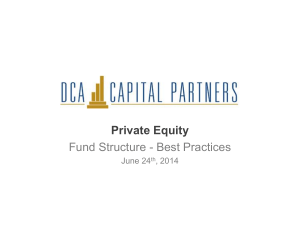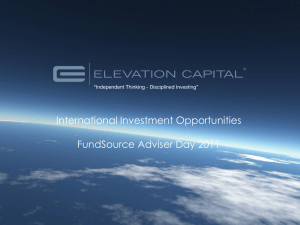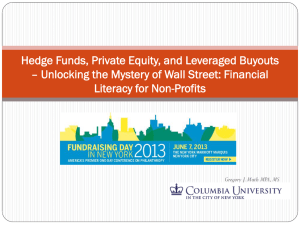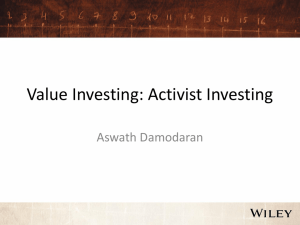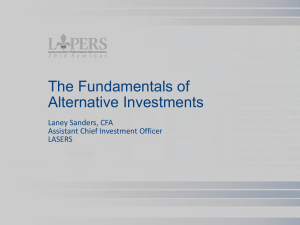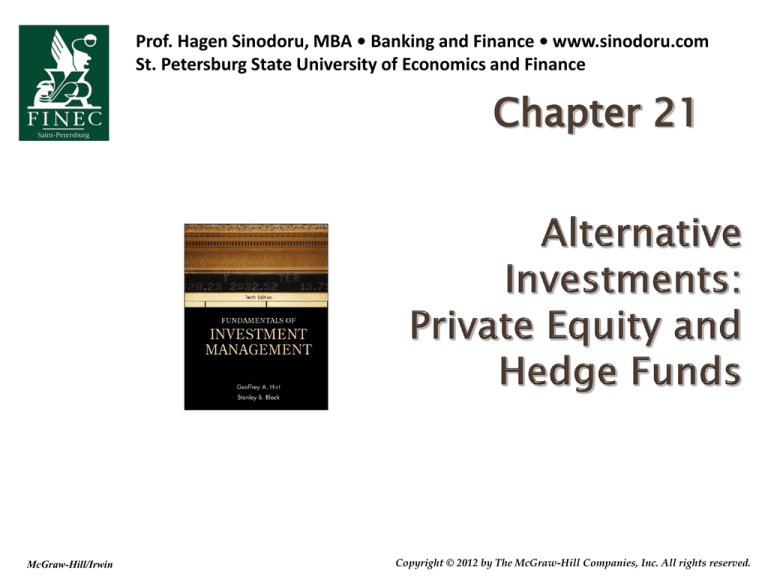
Prof. Hagen Sinodoru, MBA • Banking and Finance • www.sinodoru.com
St. Petersburg State University of Economics and Finance
Chapter 21
McGraw-Hill/Irwin
Copyright © 2012 by The McGraw-Hill Companies, Inc. All rights reserved.
Explain the different types of private equity/venture capital
funds available for investing
Explain how alternative investments can help diversify a portfolio
and enhance the risk/return trade-off
Understand the private equity process, from fundraising through
the distribution of profits, including the time horizon for the
entire process to be complete
Describe the relationship between general partners and limited
partners, and discuss how the two share returns
Understand the different hedge fund strategies and how they
generate returns and lower risk
21-2
Pension Funds
Endowment Funds
Other Large/Long-term focused portfolios
Why?
Many of these investments require large
amounts of capital to participate
The investments are often illiquid; capital may
be “locked up” for several years
Managers desire a core-satellite strategy
21-3
21-4
Core Portfolio
Traditional liquid portfolio of stocks and
bonds
Satellite Portfolios
Consists of alternative investments
Uncorrelated with the core portfolio
Reduces the standard deviation of the overall
portfolio and may increase return
21-5
All equity investments in nonpublic companies
Common Categories:
◦
◦
◦
◦
Venture Capital
Leveraged Buyouts
Mezzanine Debt
Special Situations
21-6
Raise money for investment in early/mid/late stage
companies
Firms invest after a company has a proven track
record of performance – post seed capital or angel
investment
Firms usually specialize in a specific industry or
point in the firm’s life cycle
21-7
Early-Stage
◦ Highly risky - Fail often; succeed rarely
◦ Successes tend to be very large
◦ Benefits from diversification
Middle-Stage – Expansion Companies
◦ Four to five years from IPO
◦ Need capital to meet demand for products
Late-Stage
◦ Two to three years from IPO
◦ Financing needed to dress up balance sheet for IPO
21-8
Purchase existing public companies or divisions of large,
publicly traded companies
Target companies/divisions are often distressed
◦ Bad/ineffective management
◦ Not enough capital to compete efficiently
Transactions are highly levered
◦ Company’s free cash flow is used to pay interest on debt
◦ Buyout fund is able to restructure the firm and take it public
after a few years
◦ Levered return from IPO can be very high
21-9
Who invests in a private equity fund?
Must be a qualified investor
◦ Income – Greater than $250,000 over past 3 years
◦ Investable Assets – Greater than $1 million
Popular with pension and endowment funds
◦ Investable assets are much greater than $1 million
21-10
The Funding process – four to five years
A fund solicits commitments from investors
◦ Fund managers have not identified investments
◦ Investors rely on reputation and track record of managers when
making commitment
A fund reaches a target level of commitments
◦ Begins accepting proposals from companies seeking investment
◦ Makes “capital calls” on commitments as it identifies and
executes investments
◦ Time between commitment and funding can be several years
21-11
Large public companies investing in small
nonpublic companies
Advantages for the large public company:
◦ New products/ideas may be incorporated into existing
product line
◦ Form of outsourcing R&D
Advantages for the small private company:
◦ Provide resources for marketing and testing: clinical trials,
etc.
◦ Lend general industry expertise and guidance
21-12
How do investors get their money back?
Two options to generate a payout to investors:
◦ Take the individual companies public in an IPO, or
◦ Sell the companies to strategic buyers
◦ In either case, money raised from the sale is used to pay
investors and fees
IPO market conditions can effect timing and price
received for sale
May take several years to liquidate a fund
21-13
Are a private equity fund’s fee adjusted returns
greater than that of the stock market?
General partner (fund manager) fee
◦ 20% of profits
◦ Also referred to as carried interest
Limited Partners (investors) receive 80%
Fund may have a Hurdle Rate
◦ Hurdle Rate: a minimum rate of return, usually 8-10%,
limited partners receive before general partners take their
20% carried interest
21-14
Largest predictor of success: Track Record
Funds in the top quartile of returns earn nearly
twice the median return of all funds
Follow-on funds of successful funds tend to have
the highest returns
Difficulty is in accessing these funds after they
have become successful
◦ Follow-on funds may be only offered to existing investors
◦ Successful managers may charge higher fees
21-15
Fund returns can be difficult to measure during the
life of a fund
Vintage Year: The year the fund made its first
investment
Returns can be uneven:
◦ Some investments may have been liquidated
◦ Some are being prepared to be sold
Illiquid nature of the investments makes them
difficult to price while being held in the fund
21-16
Low or negative correlation to other assets
21-17
Low / negative correlations to other assets:
◦ Reduces the overall risk of the portfolio
◦ Increases portfolio return per unit of risk
Very attractive to managers of large, longterm focused portfolios
21-18
Private Limited Partnerships
Unregulated by the SEC
Term “hedge funds” is misleading
◦ Activities are not restricted to reducing risk
◦ Generic term for funds who engage in a wide range of
activities that attempt to generate superior returns
21-19
Fees
◦
◦
◦
◦
1-2% of assets under management
20% of profits
Often referred to as “2 and 20”
Fund will often have a hurdle rate similar to private equity
funds (8-10% or an index return)
Investor qualifications are the same for hedge
funds as for private equity funds
◦ High net worth individuals
◦ Pensions and other institutional investors
21-20
Many strategies exist
The most popular:
◦
◦
◦
◦
◦
◦
◦
Long/Short Equity
Market Neutral or No-Bias
Short-Bias Funds
Event-Driven Funds
Distressed Funds
Merger Arbitrage
Convertible Arbitrage
Funds tend to be very secretive about strategy
21-21
Short sell equities the manager believes are over
valued
Use proceeds to buy equities the manager believes
are undervalued
Portfolio manager waits for the positions to
converge
In the event of a broad market fall in prices, the
short positions offset the long positions
◦ Dependent on the portfolio bias
21-22
The portfolio can have a long or short bias
◦ Long bias- Portfolio has more long positions than short
◦ Short bias- Portfolio has more short positions than long
◦ Market neutral- long/short positions balance
Many managers attempt to achieve a higher beta in
rising markets and low beta in falling
◦ Use futures and options to adjust the beta
◦ Actively manage risk with derivatives
21-23
Benefit from many types of events that can cause a
change in value
Events are uncertain - Funds must consider the
probability of the event occurring
Event Examples:
◦ Litigation outcomes, corporate spinoffs, LBOs, M&A,
Bankruptcy announcements
Event-driven funds allocate capital to profit when
specific events occur (if they occur)
21-24
Buy up the stock or debt of a company who is in bankruptcy
proceedings
◦ Most strategies involve the debt, as equity holders are usually
wiped out in Chapter 11
Fund managers believe underlying value in the distressed
security is not being priced accurately by the market
The fund may realize underlying value in security after other
liabilities are paid
Managers may take an active role in the restructuring
process and may exchange debt for equity in new firm
21-25
Speculate on the completion or failure of a merger
between two firms
Occurs post-merger announcement
Target firm will often trade at a discount to offer
price
Why price discount? - Probability of completion
◦ Could be rejected on antitrust grounds
◦ Internal board politics of either firm
◦ Could be rejected for other regulatory reasons
21-26
At completion:
◦ Target firm’s shares rise to the offer price
◦ Acquiring firm’s shares often fall
Common Strategy:
◦ Short the acquirer
◦ Use the proceeds to purchase shares of the target
◦ If equity swap: at completion, shares received are used to cover the
short position
◦ If cash purchase: cash is used to buy back acquirers shares in the
market
Alternatively, a fund manager can short the target and buy
the acquirer if she believes a deal will fail
21-27
The long/short transaction is highly levered
◦ Often the fund only has to use its own capital as margin in
the short position
◦ This could be 10-20% of the entire deal
The fund is able to realize a high ROI because of
the leverage
Losses are sudden and significant if managers are
wrong
21-28
Centers on convertible preferred stock and
convertible bonds (see chapter 13)
Common strategy:
◦ Buy convertible security
Receive interest income
◦ Short the common stock of the company
Invest proceeds from short sale into interest paying account
and earn income
Issuing companies tend to be near distress and do not pay
dividends
Covering dividends of short position restricts cash flow
21-29
Stock price rises:
◦
◦
◦
◦
◦
Gains on the conversion value of the bond
Loses on the short equity position
Gains on the interest income
Uses the conversion to cover the short position
Manager must maintain a proper hedge ratio
Stock price falls:
◦ Convertible bond reaches a floor at its pure bond value
◦ Gains on the short equity position
◦ Gains on the interest income
21-30
Many other types of strategies exist:
◦
◦
◦
◦
◦
◦
Currencies
Commodities
Global macro
Fixed-income arbitrage
Managed futures
Multi-strategy
All strategies involve selling one asset short and buying a
similar asset, e.g., Short USD and Buy EUR
Positions may have long, short, or neutral market bias
21-31
21-32
Long-term returns are more significant
◦ Represent performance during market cycles
Short bias funds have negative long-term returns
◦ Because the broad market has a general upward
trend
◦ Can be very profitable if entered at the right time
Risk/return profile is favorable compared to S&P 500
21-33
Most important: Hedge Fund returns are not highly
correlated to other asset classes
21-34
Low correlations
◦ A pension or endowment will be able to reduce long-term
volatility of the overall portfolio
◦ Able to maximize overall wealth while minimizing risk
Institutional investors continue to allocate parts of
their portfolio into hedge funds for this reason
21-35



